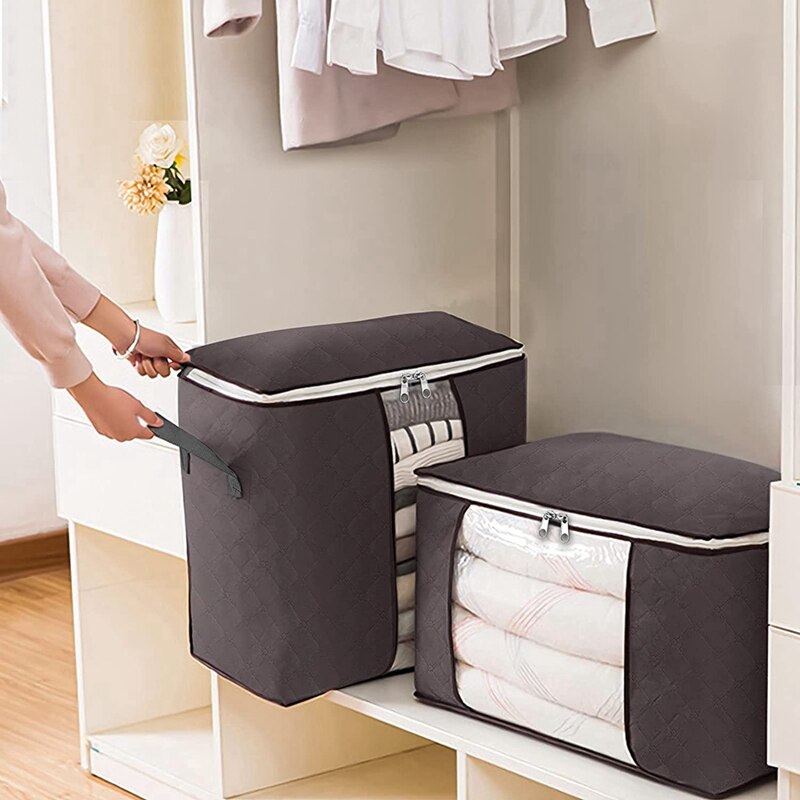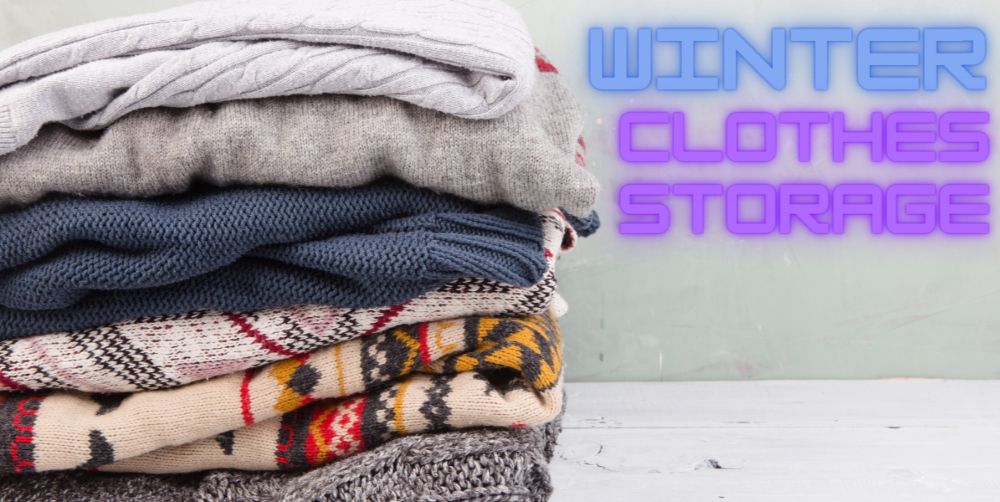10 Secrets to Keeping Your Winter Clothes Fresh While in Storage
People without enough closet space are familiar with the struggle to rotate wardrobes.
You must pull your shirts and shorts out at the end of winter and keep your winter clothing somewhere else.
But the question is, where should you keep your winter clothes for now? Is it safe to store them in the garage? How about the attic?
Keeping your winter clothes properly requires some preparations.
Maintain the freshness of your winterwear until the next time you need it by following these simple steps.
We will answer some questions about storing winter clothing when not in use and give you some helpful tips to maximize your storage space.
10 Secrets to Keeping Your Winter Clothes Fresh While in Storage
The warmth of spring and summer means it’s time to put away winter clothes and make room for the new season.
But if you don’t prepare your winter apparel correctly—which includes cleaning, repairing, and possibly recycling—they might not stay in top condition until the weather turns cold again.
Fortunately, with the right storage techniques, like using winter coat storage bags, you can keep your winter wardrobe fresh and looking like new until winter rolls around.
In this article, you’ll learn the secrets to keeping your winter clothes fresh in storage.
1. Clean all your winter clothing before packing
The perfect time to clean your clothes thoroughly is before you start packing them for the off-season.
When you store your clothes, any stains you leave on them will worsen and become more prominent over time.
It is also a lot less likely for clean and good-smelling clothes to attract the unwanted attention of insects that might bite a hole into them.
What about clothing that needs to be hand washed or dry-cleaned?
Take the time to wash your winter clothes properly.
Some may need to be dry-cleaned, and some may need to be washed by hand.
Just clean them according to their tag instructions before you store them away.
Here are a few tips to make sure that your winter clothes are ready to be packed:
- Wash every single piece of clothing
- Use deodorizer

2. Choose the right container
Cardboard boxes and plastic storage bins can both be used in storing clothes.
Just remember to check the boxes to make sure they are clean to prevent possible staining.
However, even though cardboard boxes may appear clean at face value, they may still attract insects.
And if any moisture gets trapped inside a plastic container, it will encourage the growth of mildew and mold that might cause damage to your clothes.
One of, if not the best, clothes storage containers you can use in storing off-season clothing is empty luggage that has been cleaned thoroughly.
If you want to add a layer of protection to your clothes, you may wrap them in acid-free tissue paper.
3. Be mindful of using mothballs
Mothballs are an effective solution to any insect problem.
However, remember that they are a form of toxic pesticide and can be lethal to pets and children when ingested.
A safer method of preventing insect infestation is by lining your packing container with cedar blocks.
But of course, keep in mind that no solution is fool-proof, and there is no guarantee that there will not be any bug problems.
Follow the label instructions to the tee when it comes to using any type of chemical, and store them somewhere out of children’s and pets’ reach.
4. Hang items properly
For the pieces of clothing that need to be hung, like coats for one, use all available hanging loops to maintain the shape of the clothes.
Then, wrap them with breathable material, like a fabric or garment bag.
Make sure there is enough space for air to circulate.
Doing this will reduce the possibility of mold and mildew growth and prevent creases from forming on your clothes.
We do not recommend keeping clothes in a plastic bag because they are not breathable enough.

5. Not everything should be hung
You don’t need to hang knitted pieces of clothing like sweaters because they might lose shape from being hung for a long time.
Fold them carefully instead, and then store them in a safe and clean container.
6. Stack things up in storage bins or bags
When stacking the clothing pieces you folded, start with the heaviest pieces and put them at the very bottom, then work your way to the lightest pieces on top.
Don’t overcrowd your containers with too much content; it will cause stubborn wrinkles while in storage for a long time.
Here’s a cheat sheet on which ones should be hung and which ones should be folded:
Sweaters
Fold them, then put them in a fabric bag for storage or a plastic bin if you don’t have them.
Leave enough space for air to circulate inside the container to avoid mold build-up.
Coats
Ensure all zippers are up, and buttons are done, then fold the coats with leather, faux fur, or wool material to maintain their shape.
If your coat has real fur on it, however, hang it up.
Clothes with delicate fabric
Take them out of the dry-cleaning plastic bags and wrap them in acid-free tissue paper instead, then place them inside garment bags made of cotton.
Shoes
Pack them with tissue paper to maintain their shape, then place them in plastic containers.
Boots
Place a boot form in each of them to keep its shape.
Put them in storage while on their sides.
You can keep them in plastic clothes storage bins with an old shirt or a pillowcase between each pair.
Casual clothes
Roll them instead of folding them to save space, then store them in a plastic bin.

7. Make sure your storage space is clean, dry, cool, and dark
Your storage space should be clean, dry, cool, and dark to maintain the excellent quality of your clothes.
So take the time to clean the space before using it as storage.
Go for a place less likely to be exposed to a high temperature.
Steer clear from locations with a heating source nearby.
A dark area will make sure your clothes won’t fade.
A dry place is perfect since any wetness, even moisture, can cause mold and attract insects.
8. Enclosed or open rolling garment rack
You can use this to hang sensitive clothes to maintain their shape and preserve their material.
9. Make use of the space on your wallStoring winter clothes can be tricky, especially when space is limited.
But with the right winter clothing storage solutions, you can use any available space in your house to store your winter clothes.
One such solution is to use the space on your wall for winter clothing storage.
By hanging storage bags on the walls, you can free up much-needed closet space while protecting your winter wardrobe from dust and pests.
Not only will this help to organize your winter clothes, but it will also help to protect them from permanent stains.
Additionally, you can use a spare guest bedroom closet, attic, basement, or garage to store your winter clothes.
These tips and solutions ensure that your winter clothes are well taken care of and last many seasons.
10. Visit your storage
Do not leave your storage unattended for a very long time.
Make it a habit to check your things regularly to ensure no problems.
Once you are ready to take your winter clothes out of storage, clean everything before you put them on.

Why you should store your winter clothes
As the weather begins to warm up, now is the perfect time to start thinking about proper winter clothes storage.
It’s essential to store your winter items properly to keep them in good condition and make room for your summer wardrobe.
Not to mention, proper storage can also save you space and money in the long run! Here are nine winter clothes storage tips that are worth considering.
With these tips, you can be sure that your winter clothes will be kept safe and protected when the time comes to swap out your summer wardrobe for the colder months.
Clothes that are stored properly will stay fresh and will not get damaged
Storing clothes properly can help them stay fresh and prevent them from getting damaged.
This can be done by washing and mending clothes before storing them, avoiding direct sunlight and heat, and using garment bags or acid-free tissue paper for storage.
Additionally, heavy coats should not be folded, as creases in them can become permanent, and sweaters should not be hung, as this could cause the fabrics to stretch and lose shape.
Finally, odors from our bodies and perfumes or colognes should be washed off of clothes before storage, as this prevents the spread of odors and pest infestations.
Following these steps when storing clothes can stay fresh and not get damaged.

Clothes that are stored properly will also be easier to clean when they are taken out of storage
Storing winter clothes properly is a great way to keep them clean when taken out of storage.
Take the time to properly store clothing by finding long-term storage space in a cool, dark location, getting clear bins or a storage container or garment bag that will fit your space, washing or dry cleaning your clothes, adding lavender or cedar to repel pests, and packing it all up will help ensure that clothes remain clean.
This is because the cool, dark environment helps protect clothes from dirt, dust, and pests while washing or dry cleaning them beforehand can help prevent stains from setting in.
Additionally, the addition of lavender or cedar helps repel insects or pests that could cause damage to the fabric.
By taking these steps, you can be sure that your clothes will stay cleaner when you take them out of storage.
Clothes that are stored properly will also last longer
Storing clothes properly can greatly increase their lifespan and help them last longer.
By keeping clothes in a cool and dark area with steady temperatures and low humidity, the fabrics will not be subject to extreme temperature and humidity changes, which can cause damage to fabrics.
Additionally, cleaning, folding, and hanging clothes before storage properly will help protect against odors, creases, and fabric stretching.
Finally, using garment bags, acid-free tissue paper, and other materials to store winter clothing will help keep the items from getting damaged and wrinkled.
By following these steps, you can avoid common mistakes and extend the lifespan of your clothing.
Clothes that are stored properly will also smell better
Storing clothes properly can have a major impact on their smell.
When clothes are washed and dried before they are packed away, sweat, oils, and odors that have built up on the fabric can be removed.
Additionally, odors are further prevented by adding scented sachets, dryer sheets, or cedar chips to the clothes storage bins or garment bags.
Without proper storage, clothes can accumulate odors from dirt and sweat that can be difficult to remove.
Furthermore, if clothes are left with stains, the longer they remain untreated, the harder they are to get out, making them smell even worse.
Taking the proper precautions to clean and store clothes helps maintain their freshness and extends their life.
Clothes that are stored properly will be easier to find when they are taken out of storage
Storing clothes properly helps find them when taken out of storage by providing a system for easy identification and access.
Proper storage can also help protect the clothing from pests, mold, mildew, and other permanent stains.
When clothing is stored properly, it is more organized and easier to find what you need quickly.
Also, it allows for the more spare room in closets, so you can avoid the dreaded bulge and enjoy the right-season wardrobe.

Clothes that are stored properly will also be easier to organize
Storing clothes properly is important in organizing a closet and creating a seamless transition between winter and summer wardrobes.
When clothes are properly stored in clear bins, garment bags, or vacuum bags, it will be easy to find the items you need and maintain the quality of the clothing.
Proper storage also helps avoid clutter, which can lead to misplacing items or damaging clothing.
Additionally, using resources such as empty suitcases or boxes helps conserve space, maximizing the space you have in your home.
By organizing and storing clothing properly, you can enjoy a more efficient transition from winter to spring or summer and have an easier time finding the items you need.
Clothes that are stored properly will also be easier to stack
Storing clothes properly vs. not storing clothes properly can make a big difference in the quality of the clothing and how long it lasts.
Properly-stored clothing will retain its shape, quality, and color, while clothing that isn’t stored properly may become stretched, wrinkled, or discolored.
Additionally, clothing stored properly will take up less space, as items should be folded neatly and placed in vacuum bags or hanging garment bags.
Vacuum-sealed bags are especially useful for bulky coats and ski gear.
On the other hand, clothing that isn’t stored properly can become disorganized and take up more space, as items tend to get tossed into bins or crumpled up.
Clothes that are stored properly will also be safer from household pests and moths
Properly storing clothes is essential in protecting them from pests and moths.
Cleaning your closets after removing winter clothes is one way to prevent pests, and use moth prevention items such as moth traps, cedar blocks, chips, and balls.
Vacuuming regularly in your closets or storage areas can also help keep pests away by preventing food particles from accumulating.
Alternatives to mothballs include cedar-lined storage chests, cedar blocks, balls and chips, cedar rings, and cloth pouches with aromatic dried herbs like lavender, rosemary, cloves, or thyme.
Washing and cleaning winter wardrobe items before storing them can help keep them free of moths and other pests.
Additionally, keeping them under a cover and using moth deterrent spray or cedar rings will further protect them while in storage.
Following these tips and taking the proper measures to store winter clothing will help keep them safe and free of pests and moths.
Clothes that are stored properly will also be easier to stack
Storing clothes properly can greatly affect their ability to stack.
When larger coats, ski gear, and bulky items are stored in vacuum bags or on hangers in garment bags, they conserve more space, allowing them to be properly stacked.
This can also help extend the lifespan of the clothing, as crumpled items are more likely to be damaged and not protected, as well as those stored correctly.
Additionally, folding sweaters and storage items, such as sweaters in drawers, wardrobe closets, or storage containers, will help them maintain their shape and help them stack better.
Investing in organizational tools, like a tiered hanging fabric shelf, a garment bag, and a hanging shoe organizer, can further help with stacking.
Clothes that are stored properly will also be easier to transport
Properly storing clothes can have a huge impact on the transportability of your belongings.
When properly folded and stored, clothes can be more easily packed away and transported without causing any creases or damage.
Storing clothes in a vacuum or garment bags can also protect against dust and dirt and make transporting them easier.
Additionally, when clothes are stored properly and not just thrown into bins, the quality of the items is maintained and can be reused for future outfit needs.
Having a plan for organizing and storing your clothes will save you time by making it easier to switch out your wardrobe for the seasons and save you money by preventing damage to your clothing.







